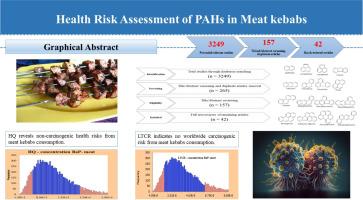基于荟萃分析和蒙特卡罗模拟的烤肉串中多环芳烃(PAHs)健康风险评估
IF 1.9
Q2 MULTIDISCIPLINARY SCIENCES
引用次数: 0
摘要
多环芳烃(PAHs)存在于各种日常食品中,引发了人们对其可能对人体健康产生有害影响的担忧。本研究旨在利用综合荟萃分析和概率风险评估框架来估计肉串中多环芳烃污染相关的健康风险。研究人员从Scopus、PubMed、Science Direct、b谷歌Scholar和Web of Science等知名数据库中发现的42项研究中,收集了2011年至2023年10月期间肉串(通过烧烤、烧烤、烤制或吸烟烹饪)中多环芳香醇含量的信息。此外,通过慢性每日摄入量(CDI)、危害商(HQ)和增量终身癌症风险(LTCR)评估健康风险,并利用蒙特卡罗模拟(MCS, 10,000次迭代)分析不确定性。调查显示,制作烤肉串的方法包括烧烤(7.4%)、烤制(11.2%)、烟熏(25.7%)及烧烤(55.7%)。芘(Pyr: 359.32µg/kg)和萘(Nap: 263.20µg/kg)的平均浓度最高,而苯并[a]芘的平均浓度较低(BaP: 1.79µg/kg)。风险评估表明,一些多环芳烃的HQ值,特别是BaP(1。× 10²)和Nap(3.93),超过了1的阈值,表明高摄入量可能具有非致癌作用。然而,根据美国环保署的指导方针,所有多环芳烃的LTCR值仍然低于1 × 10⁻26,表明终生癌症风险可以忽略不计。根据研究结果,虽然肉串在高摄入量下可能不会致癌,但终生患癌症的风险似乎在可接受的范围内。这些发现强调了推广更安全的烹饪技术和公众意识以减少通过饮食来源接触多环芳烃的重要性。本文章由计算机程序翻译,如有差异,请以英文原文为准。

Health risks assessment of polycyclic aromatic hydrocarbons (PAHs) in meat kebabs through meta-analysis and Monte Carlo simulation
Polycyclic aromatic hydrocarbons (PAHs) are included in various everyday food products, prompting worries over their possible detrimental effects on human health. This study aimed to estimate the health risks associated with PAH contamination in meat kebabs using a comprehensive meta-analysis and probabilistic risk assessment framework. The researchers collected information on PAH levels in meat kebabs (cooked by barbecuing, grilling, broiling, or smoking) from 42 studies found in well-known databases like Scopus, PubMed, Science Direct, Google Scholar, and Web of Science, covering the years from 2011 to October 2023. Furthermore, health risks were assessed through chronic daily intake (CDI), hazard quotient (HQ), and incremental lifetime cancer risk (LTCR), with uncertainty analyzed utilizing Monte Carlo simulation (MCS, 10,000 iterations). The investigation revealed that meat kebabs were made using barbecuing (7.4 %), broiling (11.2 %), smoking (25.7 %), and grilling (55.7 %) techniques. The highest average concentrations were observed for pyrene (Pyr: 359.32 µg/kg) and naphthalene (Nap: 263.20 µg/kg), while benzo[a]pyrene exhibited a lower mean concentration (BaP: 1.79 µg/kg). Risk assessment indicated that HQ values for some PAHs, particularly BaP (1.× 10²) and Nap (3.93), exceeded the threshold of 1, indicating possible non-carcinogenic effects at high intake levels. However, LTCR values for all PAHs remained below 1 × 10⁻⁶, indicating negligible lifetime cancer risk according to USEPA guidelines. According to the results, although meat kebabs may pose a non-carcinogenic concern at elevated intake levels, the lifetime cancer risk appears within acceptable limits. These findings highlight the importance of promoting safer cooking techniques and public awareness to mitigate exposure to PAHs through dietary sources.
求助全文
通过发布文献求助,成功后即可免费获取论文全文。
去求助
来源期刊

MethodsX
Health Professions-Medical Laboratory Technology
CiteScore
3.60
自引率
5.30%
发文量
314
审稿时长
7 weeks
期刊介绍:
 求助内容:
求助内容: 应助结果提醒方式:
应助结果提醒方式:


